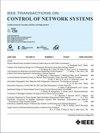概率布尔网络的事件触发稳健同步:鲁棒不变集方法
IF 4
3区 计算机科学
Q2 AUTOMATION & CONTROL SYSTEMS
引用次数: 0
摘要
本文章由计算机程序翻译,如有差异,请以英文原文为准。
Event-Triggered Robust Synchronization of Probabilistic Boolean Networks: Robust Invariant Set Approach
In this article, we consider event-triggered control (ETC) to achieve robust synchronization between Boolean networks and probabilistic Boolean networks (PBNs). The advantage of the controller in this article lies in its robustness against random disturbances, which unavoidably exist in real networks because of environmental changes. Moreover, the proposed ETC effectively reduces energy consumption, because it achieves the control objective using the shortest possible time without unnecessary updates of the feedback gain. First, robust synchronization is equivalently converted to robust set stabilization of an augmented PBN using the semitensor product. Second, a feasible algorithm is presented to calculate the largest robust control invariant set of a given set, based on which a necessary and sufficient condition is developed for the existence of event-triggered controllers. Then, a detailed configuration of all feasible controllers is provided by a constructive algorithm. Under some mild conditions, global controllers are designed to further reduce computation load. Finally, examples are provided to illustrate the main results.
求助全文
通过发布文献求助,成功后即可免费获取论文全文。
去求助
来源期刊

IEEE Transactions on Control of Network Systems
Mathematics-Control and Optimization
CiteScore
7.80
自引率
7.10%
发文量
169
期刊介绍:
The IEEE Transactions on Control of Network Systems is committed to the timely publication of high-impact papers at the intersection of control systems and network science. In particular, the journal addresses research on the analysis, design and implementation of networked control systems, as well as control over networks. Relevant work includes the full spectrum from basic research on control systems to the design of engineering solutions for automatic control of, and over, networks. The topics covered by this journal include: Coordinated control and estimation over networks, Control and computation over sensor networks, Control under communication constraints, Control and performance analysis issues that arise in the dynamics of networks used in application areas such as communications, computers, transportation, manufacturing, Web ranking and aggregation, social networks, biology, power systems, economics, Synchronization of activities across a controlled network, Stability analysis of controlled networks, Analysis of networks as hybrid dynamical systems.
 求助内容:
求助内容: 应助结果提醒方式:
应助结果提醒方式:


